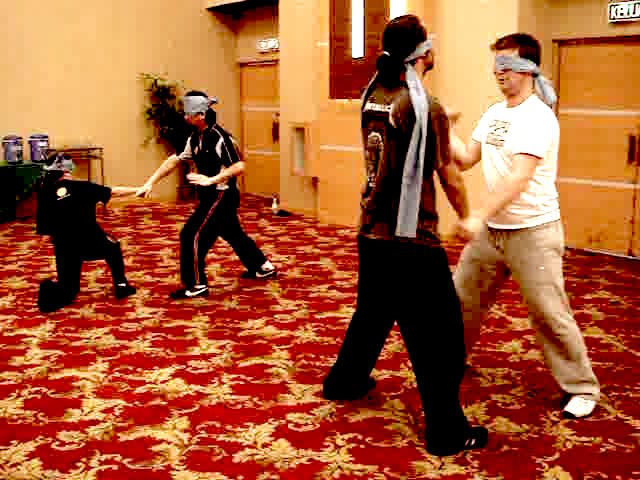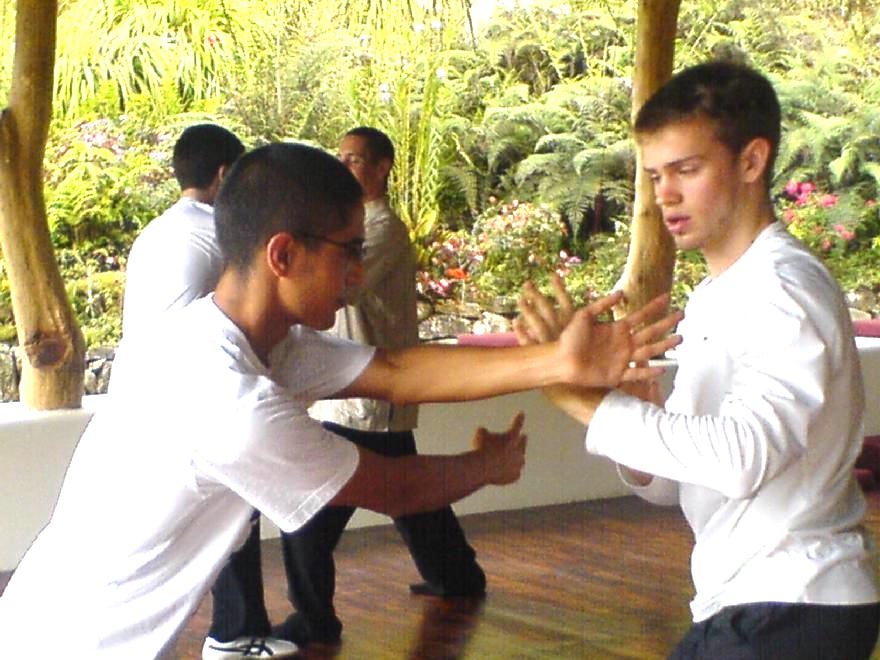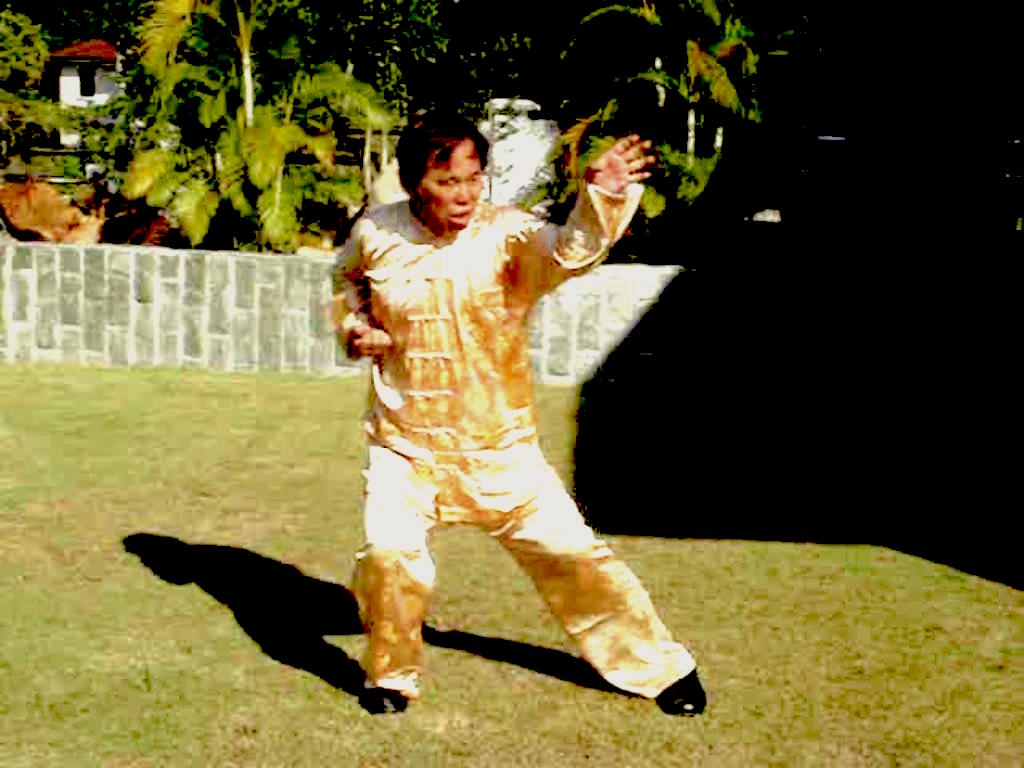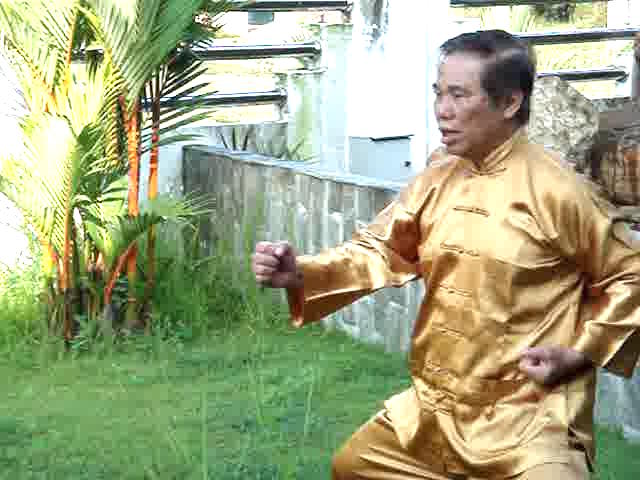SELECTION OF QUESTIONS AND ANSWERS
OCTOBER 2010 PART 2

Course participants at the Special Wing Choon Course of May 2010 practicing the skill of deflecting attacks without looking
Question 1
I have been fascinated with the course contents of the Wing Chun Course, especially the skill of how to deflect an attack without looking.
— Sifu Zhang Wuji, Singapore
Editorial Note
: Sifu Zhang Wuji's other questions can be found
here
,
here
and
here
.
Answer
Deflecting an attack without looking was a very useful benefit I had from my Wing Choon training. Gaining this benefit provides a good answer to a question some people asked me. As I was already quite accomplished after learning Shaolin Kungfu from Sifu Ho Fatt Nam, why did I still learn Wing Choon?
I did not know about this benefit at that time. The main reason why I learned from my Wing Choon master, Sifu Choe Hoong Choy, was because I wanted to continue my study of kungfu medicine.
Like Sifu Ho Fatt Nam, Sifu Choe Hoong Choy was an accomplished traumatologist.. Years ago when I was learning from Uncle Righteousness, I had heard that Wing Choon Kungfu was a highly secretive art taught only to selected disciples. As I was already learning traumatology from him, I asked whether he could also teach me Wing Choon. He kindly agreed.
From my Four Gates training under Sifu Ho Fatt Nam, I already had some skills of deflecting an attack without looking. But my Wing Choon training much refined it.
The main method to develop this skill is "Chi Sau" or "Sticking Hands". Actually it was colloquially called "chi sau loong", which means word-for-word "stick-hands-hole", and figuratively "sticking hands in circles". But for some reasons, "loong" didn't sound pleasant to me, so I preferred its more formal name of "Chi Sau".
"Chi Sau" in Choe Family Wing Choon is quite different from the "Chi Sau" we often see in popular Wing Choon schools today. As the "loong" or "hole" in its colloquial term implies, Chi Sau in Choe Family Wing Choon is more circular and flowing in its movements. We also take care of our lower body, and kicks, felling and gripping techniques are used. Participants at the Wing Choon Course are going to have a lot of fun.
Editorial Note
This and other questions were asked by Sifu Zhang Wuji and answered by Grandmaster Wong before the Special Wing Choon Course from 29th April to 5th May 2010. They are being posted now because of a long list of other questions and answers.
Question 2
Can you please say something about the relation between Wing Chun and Taijiquan?
Answer
Many people may find Wing Choon Kungfu and Taijiquan a good contrast. One is relatively linear, hard and external whereas the other is circular, soft and internal.
While there are many linear movements in Choe Family Wing Choon, it is also circular and internal. However, the internal aspect was taught only to selected disciples, and was trained via "Siu Lin Tou", its fundamental set.
There are a lot of circular movements in the second part of Siu Lin Tou, which corresponds to "Cham Kiew" in popular styles of Wing Choon. Indeed, if you perform Cham Kiew slowly, it may look like Taijiquan.
There are a lot of waist-rotation movements in the second part of Siu Lin Tou, as well as in the third part, which correspond with "Phew Chee". These waist movements reminds one of Taijiquan. Even without internal force but by rotating the waist, a small-sized exponent can handle a bigger-sized opponent.
My Wing Choon training has much influenced and benefited the development of Wahnam Taijiquan in our school. Pushing Hands in our Wahnam Taijiquan was inspired by my training in Wing Choon Sticking Hands. The development of Wahnam Taijiquan Striking Hands, which led to the formation of Taijiquan combat sequences, followed the training methodology of Wing Choon Sticking Hands.

Some people may find it odd, but Wing Choon philosophy and practice have much influenced the development of Wahnam Taijiquan in our school
Question 3
Are there other training methods in Shaolin Wahnam that are equivalent to Cham Kiew in Wing Choon Kungfu? I have been practising Pushing Hands on my own but am still not very sensitive. Can I incorporate Cham Kiew into my practice or would it be better if I continue using my Wahnam and Yang Taijiquan to train the same skill?
Answer
Yes, some techniques in "Dragon Strength Circulating Chi Set" and "Flower Set" are similar to those in "Cham Kiew". These are specialized sets, and I haven't taught them in our school yet. "Circular Hands" and "Covering Hands" which are crucial techniques in Cham Kiew are the same as the out-circle and the in-circle Cloud Hands of our Wahnam Taijiquan.
Many of the techniques in Chi Sau are found in Cham Kiew. Or, to put it in the other way, if you practice Cham Kiew you will greatly enhance your skills of Chi Sau, which will then enable you to deflect attacks without looking at them.
Tim Franklin and Mark Blohm practiced Cham Kiew as part of their preparation for the Wing Choon Course. Even before attending the curse and learning Chi Sau, they have found their practice of Cham Kiew enhanced their handling of attackers. Tim said that he could easily deflected the attacks of his students during sparring by merely using the routine movements in Cham Kiew. Mark reported that his practice of Cham Kiew enabled him to deflect the attacks of an army-trained sparring partner so effectively that the latter actually became angry.
The equivalent of Chi Sau or Sticking Hands in Wing Choon is Mang Kiew or Asking Bridge in Hoong Ka, Chai Sou or Kneading Hands in Five-Ancestor Kungfu, and Tui Sou or Pushing Hands in Taijiquan. You can find a lot of Asking Bridge in Four Gates as well as Combat Sequences 17 to 20, which are additions to our Shaolin basic combat sequences. Andrew has suggested that I conduct a course on Five-Ancestor Kungfu as part of our heritage. I may do so if the opportunity arises.
All these skills are very useful for deflecting attacks without looking at them. If I am to list them in order of effectiveness, they are as follows: Sticking Hands, Asking Bridge, Pushing Hands, and Kneading Hands. Please note that my listing is subjective; other masters may list differently.
Yes, you would improve your Taijiquan by incorporating Cham Kiew. Generally speaking, Taijiquan movements are longer and open, whereas Cham Kiew movements are shorter and closer to the body. Hence, the "short-bridge" of Cham Kiew will enhance the "long-bridge" of Taijiquan.
Question 4
I must admit I was quite attracted to the Iron Wire set because of the fact that it promotes hair growth . I have no problems with my hair but it will be nice to prevent any future balding problems while I am still young. Realistically, would it be possible for a Shaolin Wahnam student to practice all the force training methods, or would he have to discard some along the way?
Answer
While there is no doubt that all internal force training will promote hair growth, I did not know that the Iron-Wire Set was particularly known for this. Can you please tell me more about it?
In the past it was not realistic of a practitioner, master or student, to practice many force training methods. The main reason was how and what masters taught in the past was very different from how and what we now teach our Shaolin Wahnam students.
Typically it would take a student a year or two practicing stance training before he could feel any internal force. He would have to be a very good student, having practiced devotedly for at least five years, before he could be selected for specialized force training, like Iron Palm or Tiger Claw. Most other masters today also follow this conservative approach.
Hence, a student would have no opportunity to learn many force training methods. He usually focused on what his teacher had taught him. A master would also have no time to practice many methods. While the master was a student, he learned only one or two methods, and by the time he practiced them to become a master, he would just stay with them. Starting all over again with other methods was not cost-effective. He also had little chance to learn other methods, which were jealously kept as top secrets.
As Anthony Korahais has said, the way we teach is just ridiculous - in a good sense. Our students experience internal force from their stance training on the very first day of my intensive or even regional courses. In regular classes, where teaching is purposely spread out, at the most students take a month to experience internal force from stance training. Students at my regional or intensive courses spar for a few hours without panting or feeling tired. This was, and is, the ability of masters who would have trained for at least over ten years. The effectiveness of our teaching methodology is hard for other people to believe, but it is true.
Given such favorable conditions, it is only wise that our instructors and students make good use of the opportunities to learn the many force training methods that I teach. The instructors and students can still be very powerful if they stick to only one or two methods, but then they would not be taking advantage of available opportunities. These opportunities are very rare, and may not be repeated.
Imagine one can learn the secret force training methods of the Iron-Wire Set or Siu Lin Tou, for example, in just a seven-day course. It is true that he still has to train for some time to develop the force. But if he trains for 15 minutes a day for a year, his internal force will be quite considerable. Other people, now as in the past, would be grateful if they could learn the secrets after seven years with a Iron-Wire or Siu Lin Tou master.
After learning these different force training methods, our instructors and students can choose one or two to specialize in. They can practice the other methods once a while for fun or for comparision. Because they have a comprehensive understanding and experience of various force training methods, their progress in their chosen specialized methods will be very cost-effective.

Some training methods in our school are similar to Wing Choon Cham Kiew
Question 5
I have been blown away by the vast repertoire of Sifu's sets and training methods, especially the recent Iron Wire Set. I am only familiar with and practice the dynamic patterns, basic stances with its variations including "Golden Bridge" and "Three-Circle", "Lifting Water", and "Flicking Fingers".
Answer
Like you and many of our Shaolin Wahnam instructors, I was (and still am) crazy over kungfu. As a side note, one of my early students mentioned that if her husband was crazy over kungfu, the woman would be lucky because he would have no time for any vices. Of course it must be genuine kungfu. If it is debased kungfu, like what is common nowadays, he would come home injured and angry
Hence, besides having learned and practiced a great variety of kungfu, I have also read a lot about kungfu history and philosophy. This resulted in a vast repertoire of kungfu sets and training methods.
I am proud to mention that not only our instructors but even our students have accomplished the following remarkable achievements that few people in the history of kungfu could achieve.
- Even if they have not practiced the set, but by observing it they can know how to apply its patterns for combat.
- They can compose their own sets meaningfully and beneficially.
- They have found subtle joys in force training where other practitioners would find boring or demanding.
- They apply what they have learnt in kungfu to enhance their daily life.
Question 6
Can I trouble Sifu to give an exposition of the force training methods in Shaolin Wahnam (only if Sifu is prepared to, of course)? Are certain methods more suitable for some than others? For example, would Iron Wire be unsuitable for some students?
Answer
Force training can be classified into two main categories, namely basic force training and specialized force training. Another way is to classify force training into external force training and internal force training. These classifications are for convenience; sometimes it may not be easy to differentiate one type from another.
These two modes of classification are not exclusive. Basic force training can be external or internal. Similarly, specialized force training can also be external or internal. For example, stretching one's legs to make them flexible is basic force training. It can be performed externally as in most leg stretching exercise, or it can be performed internally like when we perform "Three Levels to Ground" as chi kung. Tiger-Claw is specialized force training. It can be attained externally like gripping jars filled with sand or water, or it can be attained internally like performing "Fierce Tiger Cleanses Claws".
On the other hand, external force training can be applied to basic force or specialized force, and internal force training can also be applied to basic force or specialized force. For example, striking a sand-bag is external force training. It can be used to develop basic force like having a powerful punch, or it can be used to develop specialized force like Iron Fist. Regulating one's breath is internal force training. It can be used to develop basic force like increasing our stamina as in performing "Four Gates", or to develop specialized force like the Small Universe.
Basic force training is practiced by all students, whereas selected students are taught certain specialized force training. External force training involves the training of muscles, bones and skin, whereas internal force training involves the training of essence, mind and energy.
Actually, as soon as our students practice Shaolin Kungfu or Taijiquan the way we have taught them, they are undergoing force training, because every movement in our practice is a training of energy and mind. Even without doing any other ways of force training, just by practicing our Shaolin or Taijiquan movements for some time, our students will be healthier and fitter, and have more power, more stamina, better agility and more mental clarity. This is basic internal force training, and is another of the achievements even masters may not attain.
How do our students derive such benefits? It is because right at the start of their Shaolin or Taijiquan career, we initiate them into energy flow and standing meditation.
Apart from this basic internal force training, our school is very rich in force training methods. We pay much attention to stances and footwork, which may be described as external or internal training depending on our approach and emphasis. When we focus on the correct positions of the stances and their correct movement, including starting with the back leg and rotating the waist, the training is external. When we focus on developing internal force in our stances, and using chi instead of muscles to move in our footwork, our training is internal.
Similarly, "Thirty Punches", the "Art of Flexible Legs" and "Hundred Kicks" may be regarded as basic external or basic internal training depending on approach and emphasis. On the other hand, "One-Finger Shooting Zen", "Golden Bridge", "Three-Circle Stance" and other modes of zhan zhuang like "Carrying Water", "Embracing the Sun" and "Playing the Lute" are basic internal force training.
Examples of specialized force training are Iron Palm, Iron Arm and Iron Leg, which are external, and Cosmos Palm, Tiger-Claw, Eagle-Claw, No-Shadow Kick and Golden Bell, which are internal.
In the early days of our school, I used sand-bags, wooden poles and stone-locks (or dumb-bells) for external training. When students specialized on some particular modes of training, they would develop Iron Palm, Iron Arm and Iron Leg. But later I discarded these external training for internal training, which is far superior.
The Iron-Wire Set is excellent for internal force training. Other sets in our school which are also excellent for internal force training are Siu Lin Tou, Triple Stretch, Flower Set and Dragon-Strength Chi-Channeling Set. These are specialized sets and the training is internal.
Yes, some force training methods are more suitable for some students than for others. When I learned from Sifu Ho Fatt Nam, I did some Iron Palm training. One night, he looked at my palms and said, "You have gentle hands. Don't do Iron Palm." For a moment I though I would lose the opportunity of force training. But my sifu continued, "I'll teach you Cosmos Palm".
My sifu explained, "You're a scholar, Iron Palm is not suitable for you. Your siheng, Por Lok, is an ironsmith, Iron Palm training is excellent for him. In fact his work is his training."
Like other forms of internal force training, the Iron-Wire Set is not suitable for those who lack patient and refinement. If they do not follow instructions properly or try to rush their training, Iron-Wire training may bring harm to them. Nevertheless, a good teacher can help such students to overcome these setbacks.

Our school is very rich in internal force training methods. An excellent example is "Ta Chong", or "force training on stance" of the Triple Stretch Set.
Question 7
What are some ways to practice Marvelous Fist?
— Tom, USA
Answer
Marvelous Fist in one of the three "Ultimate Martial Arts", the other two being "One Finger Zen" and "Strike-Across-Space Palm".
As it is a very advanced art, it is not taught openly. One needs to be a specially selected inner-chamber disciple before he has a chance to be taught this advanced art by a master.
However, even if you are told the training methods, you would not be able to perform it because you don't have the required skills. For example, one of the methods is to punch at a sand-bag without touching it from a distance of a few feet so that the force from the punch can push the sand-bag away. You may try the method but you will have no result.
Question 8
I have studied and practiced internal exercises for over a year. I want to train safely.
Answer
It is generally unsafe to train internal arts on your own without a master's personal supervision. Even when you follow the instructions exactly, you may harm yourself. Often you may not know the harm until it is too late.
But how can one harm himself when he follows instructions exactly? Let us take an example. A very common instruction in any internal arts is to sink the chi, or intrinsic energy, to the dan tian, or abdominal energy field. If you do this without a master's guidance, you may force your chi down pressing detrimentally on your gall bladder or sex organs.
More often you may perform the exercise incorrectly when you think you are following the instructions exactly. For example, an important instruction requires you to be relaxed. But you tense yourself when performing the exercise though you erroneously think you are relaxed. This is a very common mistake amongst those who practice on their own.
LINKS
Selected Reading
- Top Ten Shaolin Wahnam Warriors 2010
- Sparring and Kungfu Culture
- The Three Secrets
- Hei Sai or the Spirit of Energy
- Various Ways to Counter a Boxer
